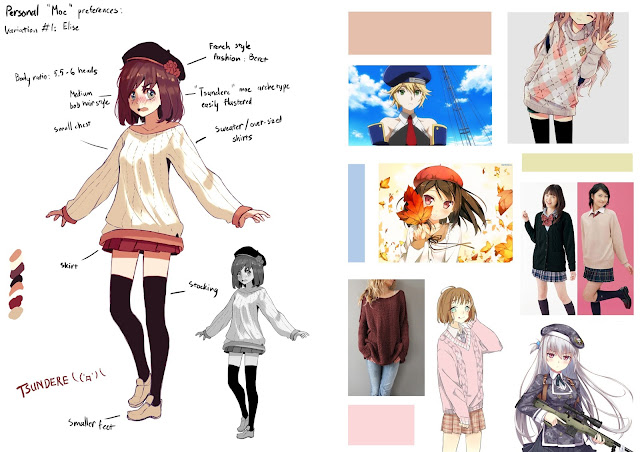For my practical response, I decided to visually break down the different elements/stages in the creation process of a moe girl/ anime-style girl in general, from body proportion, hair style, to face size and eye shapes. Doing so, it presented a clearer image of the evolution of the style with the gradual increase of moe applications, as well as a better understanding in the attractive points of different moe-elements.
 In terms of body proportions, from what I can gathered, a large proportion of identified "moe" girls usually have 5-5.5 heads body proportion with really slender arms and legs ( for a younger , more cutesy appearance). More over, body doesn't necessarily communicate the age of the character, as "moe" adult character can also have a child-like appearance as well, sometime confusingly so.
In terms of body proportions, from what I can gathered, a large proportion of identified "moe" girls usually have 5-5.5 heads body proportion with really slender arms and legs ( for a younger , more cutesy appearance). More over, body doesn't necessarily communicate the age of the character, as "moe" adult character can also have a child-like appearance as well, sometime confusingly so.
"She's a mom,... yeah"
Eyes shape are iconic to the genre. Interestingly enough, there's actually different words used to describe the eye shape use in Japanese-style character : Tareme (preference in the above), which describe the eye shape that is slanted in the outer corners and Tsurime, the opposite to it which are raised in the corners. Tareme eyes then signifies a more timid and shy personality which are more in the line traditional ideas of "moe". Moreover , the size of the pupils can also influence the levels of moe the character exert ( similar to that of the puppy eyes effect). Overtime , the emphasis on larger pupils are more prominent.
Hairstyle also plays into different tropes of anime as they can be linked to different archetypes. Examples being : Side bangs signifies a more "traditional"/ mysterious girl, Twintails are used a lot for little sister type, or tsundere type of moe, and Long, wavy here are used for Westerner characters, or people of Royalty. On top of that , different shades of colour also signifies different personality traits , such as blue hair represent a calm and mature character and red representing passion and a fiery attitude.
After getting all the technical aspect down ( to a certain level at least ) , I began various attempts of creating my own moe design, and then put them up for an online survey, to judge the level of effectiveness of them. Doing this , I hope it can validates some points in the essay about the popularity of moe archetypes as well as showing the difference in taste among different sectors of the audience.































